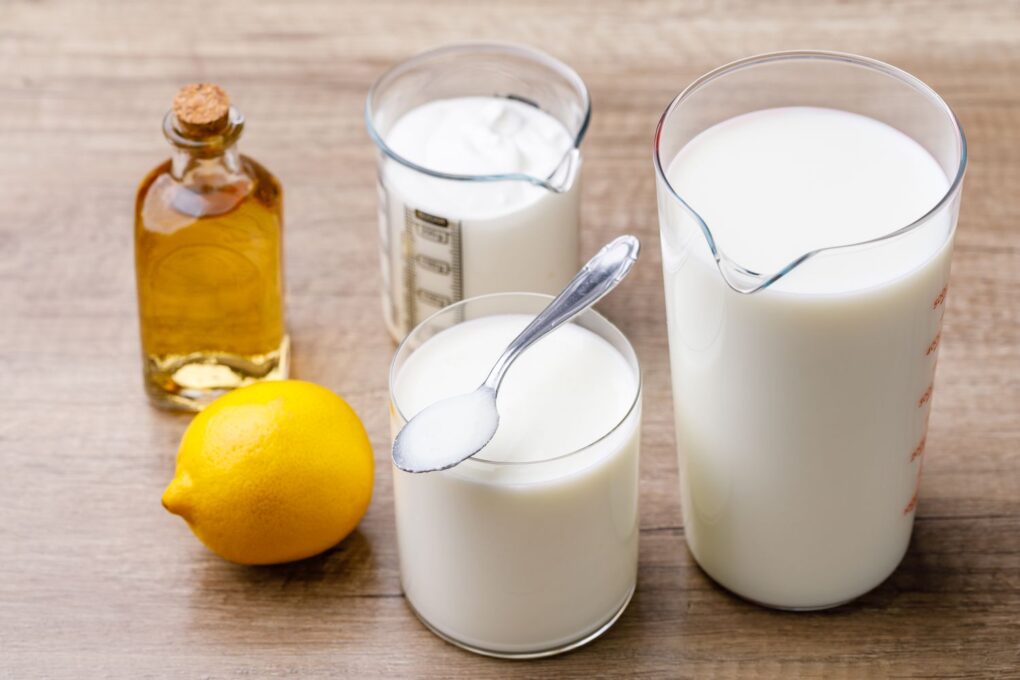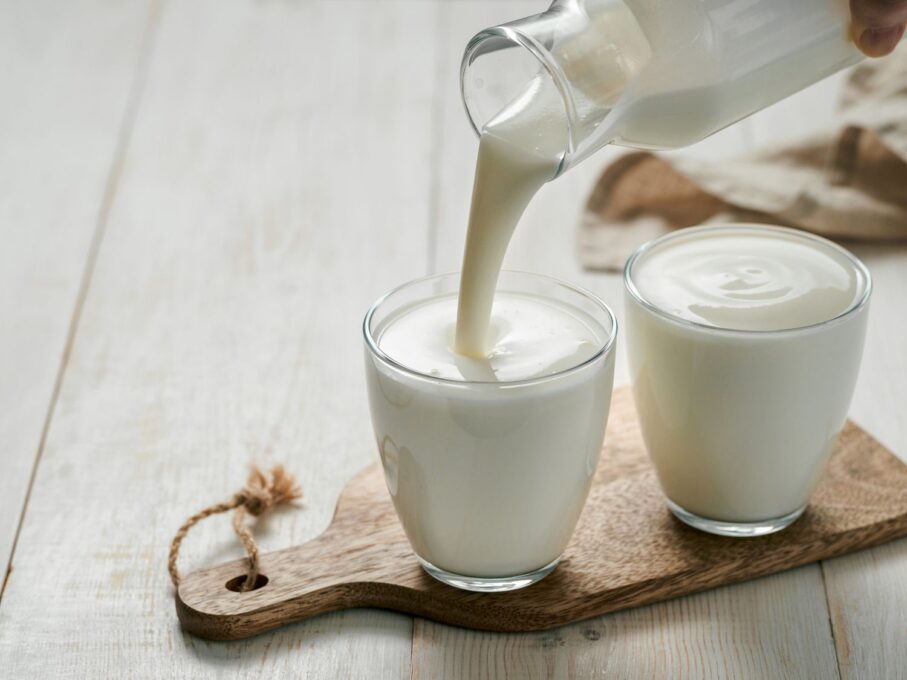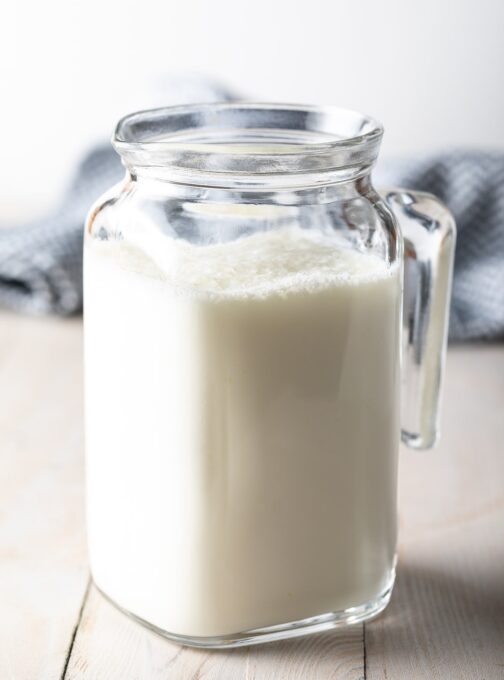How to make buttermilk? Whether you want to use it in your baking or as a refreshing drink, making your own buttermilk is easy and affordable. This versatile dairy product is a great substitute for milk, sour cream, or yoghurt in recipes and can add tanginess and richness to your dishes.
Buttermilk is a fermented dairy product that is commonly used in cooking and baking. Traditionally, buttermilk was the liquid left over after churning butter from cream. However, modern buttermilk is typically made by adding lactic acid bacteria to milk.
This fermentation process gives buttermilk its distinctive tangy flavour and slightly thick consistency. Buttermilk is a versatile ingredient that can be used in a variety of dishes, including pancakes, biscuits, cakes, and marinades. It is also a great protein, calcium, and other essential nutrients source.
In this article, we will show you different methods to make buttermilk at home using common ingredients, so you can enjoy this delicious and healthy dairy product anytime you want.

CHECK THESE OUT:
- Chicken Legs Recipe Drumstick: How to make them
- Easy Nigerian Sandwich Recipe (Quick and Easy)
- How to Make Chicken and Chips
Ingredients for making Buttermilk
To make buttermilk at home, you will need:
Milk
You can use any type of milk, including whole milk, skim milk, or even plant-based milk like almond or soy milk.
Acidic Ingredient
Buttermilk is acidic in nature; to make it at home, you will need an acidic ingredient. This can be vinegar, lemon juice, or even yoghurt.
Mixing Bowl
You will need a large mixing bowl to combine the milk and acidic ingredients.
Whisk or Spoon
You will need a whisk or spoon to thoroughly mix the milk and acidic ingredients.
Measuring Cups and Spoons
To ensure you have the right ratios of ingredients, you will need measuring cups and spoons.
Time: It takes a few minutes for the milk and acidic ingredient to combine and create buttermilk, so you will need time to allow this process.
SEE THIS:
- How Many Pints are in a Gallon
- “How Many ML in a Cup? Your Essential Guide to Accurate Measurements
- How Many Teaspoons in a Cup
- How Many Ounces in a Cup
Methods of making Buttermilk
There are several methods to make buttermilk at home. Here are three popular methods:
Using Milk and Vinegar/Lemon Juice:
Add one tablespoon of vinegar or lemon juice to one cup of milk.
Stir well and let it sit for 5-10 minutes.
The mixture will curdle and thicken, resembling the texture of buttermilk.
Use immediately or refrigerate for later use.
Using Yogurt and Milk:
Combine 1/2 cup of plain yoghurt with 1 1/2 cups of milk.
Whisk well until fully blended.
The mixture will have a creamy consistency and tangy flavour, similar to buttermilk.
Use immediately or refrigerate for later use.
Using Cream of Tartar and Milk:
Add 1 1/2 teaspoons of cream of tartar to one cup of milk.
Stir well until fully combined.
Let the mixture sit for 5-10 minutes.
The mixture will curdle and thicken, resembling the texture of buttermilk.
Use immediately or refrigerate for later use.

Buttermilk Substitute
Powdered Buttermilk
Ingredients: 1/4 cup powdered buttermilk + 1 cup water = 1 cup buttermilk
Powdered buttermilk is genius! You can find it in the baking aisle of many grocery stores; it’ll keep in your pantry for months. Mix it in with your dry ingredients, then use water in place of the buttermilk in the batter.
Kefir
Ingredients: 1 cup plain kefir = 1 cup buttermilk
Kefir is a fermented milk drink that can be used cup for cup to replace buttermilk. If needed, thin it out with a splash of milk or water.
Non-Dairy Yogurt
Just like regular yoghurt, non-dairy yoghurts work well as buttermilk substitutes. Look for soy, almond, or even coconut yoghurt (but note that the flavour of coconut may impart on your dish).
Alternative Milk and Lemon Juice
Ingredients: 1 cup unsweetened almond or soy milk + 1 tablespoon lemon juice.
If you’re looking for a vegan alternative to buttermilk, try your favourite soy milk or almond milk instead! Combine one tablespoon of lemon juice with 1 cup of unsweetened, non-dairy milk (soy and almond work best) and let it sit for a few minutes.
Sour Cream and Water or Milk
Ingredients: 3/4 cup sour cream + 1/4 cup water or milk = 1 cup buttermilk
Sour cream has a tangy flavour similar to buttermilk, but it’s much thicker, so it needs to be thinned out with a little water or milk. Mix 3/4 cup sour cream with 1/4 cup water or milk.

Tips to keep in mind while making Buttermilk
here are some tips you can keep in mind while making buttermilk:
Use fresh milk
While making buttermilk, it’s important to use fresh milk. If the milk is too old or has gone sour, it won’t work as well.
Use whole milk
Whole milk makes the best buttermilk. You can use other types of milk, but the result won’t be as good.
Use a good starter
You can use a commercial buttermilk starter or a homemade one. If you’re using a homemade starter, make sure it’s fresh and active.
Don’t overmix
When you mix the starter with the milk, don’t overmix it. Overmixing can make the buttermilk thin and watery.
Let it sit
After you’ve mixed the starter with the milk, let it sit for a few hours. This allows the bacteria to do their job and thicken the milk.
Read: How to Make Moi Moi
Use a clean container
Make sure the container you use to store the buttermilk is clean. Any bacteria or dirt can contaminate the buttermilk and make it go bad faster.
Store properly
Store the buttermilk in the refrigerator and use it within a week or so. The longer it sits, the sourer it will become.
READ ALSO: How to cook Okro Soup – Nigerian Okro Soup Recipe
Health Benefits of Buttermilk
It can help your bones
Buttermilk is an excellent source of calcium. Your bones, teeth, and blood all include significant amounts of calcium, making it the most common mineral in your body.
It helps keep your cholesterol levels healthy
It can help keep your Cholesterol levels healthy. Studies have shown that a small amount of buttermilk each day can help lower cholesterol and triglyceride levels in people with high cholesterol levels. High cholesterol is tied to heart disease and strokes, so keeping your levels healthy will help your health.
Immunity Boost
Buttermilk is rich in vitamin B12 and other nutrients that help in boosting the immune system. It also contains lactic acid, which has antimicrobial properties that help in fighting against harmful bacteria and viruses.
Skin Health
Buttermilk contains lactic acid, a natural exfoliant that helps remove dead skin cells and promote healthy skin. It also contains alpha-hydroxy acids (AHAs), which help in reducing fine lines, wrinkles, and other signs of ageing.
It makes the gut healthier.
The healthy bacteria added to buttermilk offer another benefit: they act as probiotics. Your gut is filled with bacteria that help you digest your food.
SEE: Vegetable Soup Recipes: How To Cook the Nigerian Efo Riro
Potential Risks of Buttermilk
Although people who have lactose intolerance may find they are better able to tolerate buttermilk, remember that it is still a dairy product.
People who have dairy allergies or are particularly sensitive to lactose should be cautious about buttermilk. It’s also not a low-calorie food, so if you are trying to limit your calories, be sure to have just one or two 8-ounce servings a day.
Storing Buttermilk
Storing buttermilk properly is essential to ensure that it stays fresh and does not spoil quickly. Here are some tips to help you store buttermilk correctly:
Refrigerate immediately
Once you have made buttermilk, transfer it to a clean, airtight container and immediately place it in the refrigerator. The ideal temperature for storing buttermilk is between 34°F to 40°F (1°C to 4°C).
Keep away from strong odors
Store buttermilk away from strong-smelling foods like garlic, onions, or cheese. Buttermilk can easily absorb other flavours and smells, which can alter its taste.
Shake well before using
Before using the buttermilk, give the container a good shake. This will help to distribute the lactic acid and fat evenly throughout the liquid, giving you a consistent flavour.
Use within the expiry date
Check the expiry date on the container and use the buttermilk before it expires. Over time, the acidity of the buttermilk increases, which can lead to spoilage.
Freeze for long-term storage
If you have leftover buttermilk that you cannot use within the expiry date, consider freezing it. Pour the buttermilk into an ice cube tray and freeze it. Once frozen, transfer the buttermilk cubes to a freezer bag and store them in the freezer. Buttermilk can last up to three months in the freezer.
By following these tips, you can store buttermilk properly and use it whenever you need it.
SEE: How to cook catfish pepper soup
Conclusion
In conclusion, making buttermilk at home is a simple and cost-effective way to add a tangy flavour to your dishes. You can make buttermilk in just a few minutes by using common ingredients and following the easy-to-follow methods.
Whether you’re using buttermilk for baking, marinating or just for drinking, it’s an essential ingredient to have on hand in the kitchen.
By keeping these tips in mind and experimenting with different methods, you can create the perfect buttermilk for all your culinary needs. So, go ahead and try making your own buttermilk at home and enjoy its delicious and unique taste!
FAQS For How To Make ButterMilk
How can I make buttermilk at home?
To make 1 cup (240 mL) of buttermilk substitute, add 1 tablespoon (15 mL) of lemon juice to a liquid measuring cup. Then, add milk to the 1-cup line (240 mL) and stir. You can either use fresh-squeezed lemon juice or bottled lemon juice.
What can I use if I don’t have buttermilk?
Here are several dairy-based buttermilk substitutes.
Milk and vinegar:
You can use any kind of milk, but if your recipe calls for a certain type of buttermilk — such as low-fat — it may be best to use a similar type of milk to make a substitute.
Milk and lemon juice:
To make 1 cup (240 mL) of buttermilk substitute, add 1 tablespoon (15 mL) of vinegar to a liquid measuring cup. Then, add milk to the 1-cup line (240 mL) and stir.
Lemon juice is an acid that you can use instead of vinegar to make buttermilk.
To make 1 cup (240 mL) of buttermilk substitute, add 1 tablespoon (15 mL) of lemon juice to a liquid measuring cup. Then, add milk to the 1-cup line (240 mL) and stir. You can either use fresh-squeezed lemon juice or bottled lemon juice.
Milk and cream of tartar:
To make a buttermilk substitute, use 1 3/4 teaspoon (5 grams) of cream of tartar per 1 cup (240 mL) of milk. Cream of tartar tends to clump when stirred directly into the milk. Therefore, it’s better to mix the cream of tartar with the other dry ingredients in your recipe, then add the milk.
Lactose-free milk and acid:
You can make a buttermilk substitute with lactose-free milk though it may taste a little sweet. Simply add 1 tablespoon (15 mL) of lemon juice or vinegar to a liquid measuring cup. Then, add lactose-free milk to the 1-cup line (240 mL) and stir.
Sour cream and water or milk:
Sour cream is thicker than buttermilk, so it’s best to thin it with water or milk when making a buttermilk substitute. To replace 1 cup (240 mL) of buttermilk in a recipe, combine 3/4 cup (172 grams) of sour cream with 1/4 cup (60 mL) of water or milk and whisk the mixture until smooth.
Plain yoghurt and water or milk:
You can replace buttermilk cup for cup with plain yoghurt, but it may work better to thin the yoghurt with water or milk, especially for recipes that make a thin batter, such as cake.
To make 1 cup (240 mL) of buttermilk substitute, combine 6 ounces (170 grams) of plain yogurt with 1/4 cup (60 mL) of water or milk and whisk until smooth
What is the formula of buttermilk?
1/4 cup buttermilk: 3/4 teaspoon vinegar or lemon juice + 1/4 cup milk of choice. 1/3 cup buttermilk: 1 teaspoon vinegar or lemon juice + 1/3 cup milk of choice. 1/2 cup buttermilk: 1 1/2 teaspoons vinegar or lemon juice + 1/2 cup milk of choice.
